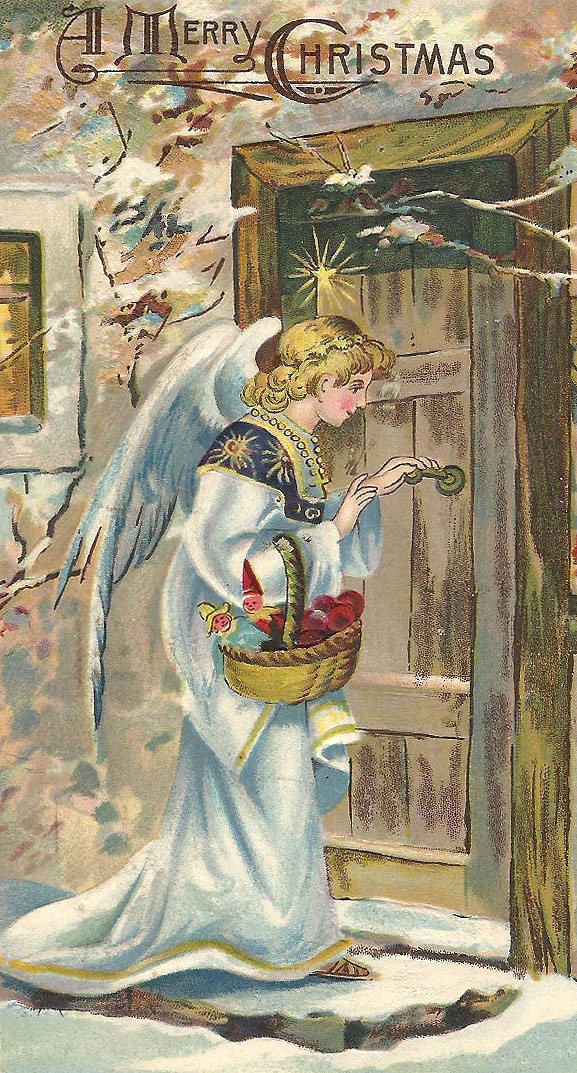In many parts of Germany the secret delivery of gifts on Christmas Eve is attributed not to Santa Claus but to the Christkind (“Christ Child”)—or, in diminutive form, Christkindl. The idea that the baby Jesus is responsible for such a service originated with the Protestant reformer Martin Luther, who wanted to shift the association of gift giving away from St. Nicholas. Up until this point in history, gifts were exchanged in St. Nicholas’s name on his feast day, December 6; this was the major gift giving holiday, which children especially looked forward to. Luther, however, promoted December 24 as the primary date of gift giving, to link the receiving of good things with the receiving of the greatest thing: God in Christ, a savior.

This detail image of the Christkind entering through a window is found on an antique metal Christmas tree stand. The inscription translates to “The Christ Child comes to our house.”
Since Luther’s time the popular conception of the Christkind has evolved from a little blonde-haired boy (a Germanized Jesus) into a feminine angel, whose relationship to Jesus is unclear. Some say the Christkind is a messenger of Jesus; others say she is simply one who demonstrates Christ-like virtue. The angelic representation of the Christkind likely arose as a conflation of characters from nativity plays and Christmas parades, in which the Christ child is attended by angels.
On Christmas Eve night children are told to wait in their rooms for the arrival of the Christkind, who announces her delivery by ringing a bell. By the time the children run out of their rooms to greet her, she is gone, and the living room is filled with freshly laid gifts, which the children proceed to open right then (rather than waiting till the morning, as in America). In some homes it is the Christkind who sets up the family Christmas tree, or is at least the one who decorates it.
Like Santa Claus, the tradition of the Christkind is just as readily embraced by nonreligious families as by religious ones. Also, even though the figure was conceived as a reaction against the Catholic veneration of saints, Catholics have latched on to it and are now one of the foremost groups to observe the Christkind’s coming.
In vintage Christmas postcards (ca. 1880–1920) from Germany and surrounding countries, there are a range of visual interpretations of the Christkind. Gender is one variable, though female is the predominant choice. The age of the Christkind also varies, from about two years old to twenty-two. Her head may be adorned with a star headband, holly, a halo, or some combination of the three.
One constant in the iconography is the Christkind’s journey through a snowy landscape, bearing gifts. Sometimes she is shown as a wingless human with a hooded fur coat (perhaps borrowing from the iconography of Snegurochka the Snow Maiden of Russian fairy tales, the granddaughter and helper of Ded Moroz).
But more frequently she is shown as an angel.

Book cover for Die Fahrt zum Christkind: Ein Weihnachts-Märchenbuch (The Journey of the Christkind: A Christmas Storybook) by Julius Lohmeyer, with illustrations by V. P. Mohn (Glogau, Silesia: Carl Flemming, 1889). Click on the image to see more illustrations from the book.
Often she is accompanied by a deer who helps her carry a basketful of fruits and toys and a Christmas tree.
Sometimes, though, she pushes her goods in a wheelbarrow.
When she arrives at a destination house, she may enter through a window or through the front door. Either way, she is quiet and stealthy, so as to avoid being noticed.
Occasionally she is assisted by one or more other angels, with no apparent hierarchy between them.
On other occasions she clearly exercises leadership over a team of . . . elf-angels?

“Im Lande des Christkinds” (In the Land of the Christkinds), an Advent calendar by Richard Ernst Kepler, published 1903.
Most interesting to me are those cards that show Santa Claus with the baby Jesus. It’s rare to see them in collaboration! Usually in this context Jesus is shown riding a donkey, being led by Santa, or else Santa pulls Jesus in a sleigh or carries him on his shoulders. Whatever the mode of transport, Jesus bears the position of honor and is made the focal point of the image by virtue of his bright, shining halo. Sometimes he even wears a crown of candles on his head.
These vintage illustrations suggest the peaceful coexistence of both traditions: the sixteenth-century Christkindl, and the relatively newer phenomenon of Santa. In modern-day Germany some parents have given up teaching their kids about the Christkindl, having surrendered to the global influence of Santa. Others have found a way to fuse the two mythologies. Still some remain faithful to Luther’s model, despite the ubiquity of Santa-centric holiday marketing.
The Christkindl tradition never spread much beyond central Europe, but the name “Christkindl” did find its way into American Christmas vocabulary in the form of “Kris Kringle,” an anglicized corruption. (In America, Kris Kringle is another name for Santa.)
To add further to the iconographic variation of the Christkind: Every two years the famous Nuremberg Christmas Market in Germany crowns a new Christkind from among a pool of female applicants between the ages of sixteen and nineteen. The face of Christmas to locals, the Nuremberg Christkind ceremoniously opens the Christkindlesmarkt just before Advent, dressed in regalia that looks more fairy queen than kid angel, and certainly nothing like baby Jesus.
In sum, much like the historical St. Nicholas underwent extensive modification over time to become the Santa Claus we know today, so did the Christ child. But unlike today’s American Santa, the iconography of the German Christkindl is much less standardized. Which is why, for example, online image searches are difficult: many images in which he/she appears are labeled “angel” instead—or, in the absence of wings, simply “child.” The Christkind, however, is no generic angel or child; his/her attributes include an assortment of goodies and toys, a Christmas tree, and a bell. Pinterest user Jim Gould has done a great job collating an array of Christkind images.
If you observe the Christkind tradition in your home, or if you did as a kid, I’d love to hear how you do it, and what memories you attach to it. In your family, what is the folklore of the Christkind? How do you envision him/her?
Also, is the Christkind still used in Christmas marketing—that is, in seasonal commercials and greeting cards and such? I’m too far removed from German pop culture to know . . .






















Thank you – very fascinating!
I found your blog while researching images of the Christkind, and I so appreciate the work you put into it. Here in Chicago we have a Christkindlmarkt, and I became curious about the blond female character featured as the Christkind. The idea started with Martin Luther wanting to take attention away from St. Nicholas/Santa Claus and refocus back to Christ. Because early depictions were of a curly haired blond child wearing a long dress-like robe, I suppose it was natural to transition to an adult female for presentation purposes at markets. It seems the public mostly recognizes depictions of Christ as the adult Savior with a beard, usually in association with His crucifixion. Interesting, isn’t it?
Do you know of any children’s books about the Christkind?
I do not, sorry. You might be able to find something by searching the Books section of Amazon, though.
Pingback: Will Muslims Celebrate Christmas? – twopennyposts
I saw my first Christmass Angel in 2014 the most beautiful in mind body spirit I have ever seen I was injured and then a second Christmas Angel came rescued me in Hamburg and brought to safe harbor. God Bless Germany